ASUS DSBV-D User Manual

DSBV-D
Motherboard

E3043
Second Edition V2
February 2007
Copyright © 2007 ASUSTeK COMPUTER INC. All Rights Reserved.
No part of this manual, including the products and software described in it, may be reproduced, transmitted, transcribed, stored in a retrieval system, or translated into any language in any form or by any means, except documentation kept by the purchaser for backup purposes, without the express written permission of ASUSTeK COMPUTER INC. (“ASUS”).
Product warranty or service will not be extended if: (1) the product is repaired, modified or altered, unless such repair, modification of alteration is authorized in writing by ASUS; or (2) the serial number of the product is defaced or missing.
ASUS PROVIDES THIS MANUAL “AS IS” WITHOUT WARRANTY OF ANY KIND, EITHER EXPRESS OR IMPLIED, INCLUDING BUT NOT LIMITED TO THE IMPLIED WARRANTIES OR CONDITIONS OF MERCHANTABILITY OR FITNESS FOR A PARTICULAR PURPOSE. IN NO EVENT SHALL ASUS, ITS DIRECTORS, OFFICERS, EMPLOYEES OR AGENTS BE LIABLE FOR ANY INDIRECT, SPECIAL, INCIDENTAL, OR CONSEQUENTIAL DAMAGES (INCLUDING DAMAGES FOR LOSS OF PROFITS, LOSS OF BUSINESS, LOSS OF USE OR DATA, INTERRUPTION OF BUSINESS AND THE LIKE), EVEN IF ASUS HAS BEEN ADVISED OF THE POSSIBILITY OF SUCH DAMAGES ARISING FROM ANY DEFECT OR ERROR IN THIS MANUAL OR PRODUCT.
SPECIFICATIONS AND INFORMATION CONTAINED IN THIS MANUAL ARE FURNISHED FOR INFORMATIONAL USE ONLY, AND ARE SUBJECT TO CHANGE AT ANY TIME WITHOUT NOTICE, AND SHOULD NOT BE CONSTRUED AS A COMMITMENT BY ASUS. ASUS ASSUMES NO RESPONSIBILITY OR LIABILITY FOR ANY ERRORS OR INACCURACIES THAT MAY APPEAR IN THIS MANUAL, INCLUDING THE PRODUCTS AND SOFTWARE DESCRIBED IN IT.
Products and corporate names appearing in this manual may or may not be registered trademarks or copyrights of their respective companies, and are used only for identification or explanation and to the owners’ benefit, without intent to infringe.
ii

Contents
Notices........................................................................................................ |
vii |
Safety information..................................................................................... |
viii |
About this guide.......................................................................................... |
ix |
Typography................................................................................................... |
x |
DSBV-D specifications summary............................................................... |
xi |
Chapter 1: |
Product introduction |
|
|
1.1 |
Welcome!....................................................................................... |
1-1 |
|
1.2 |
Package contents......................................................................... |
1-1 |
|
1.3 |
Serial number label....................................................................... |
1-1 |
|
1.4 |
Special features............................................................................ |
1-2 |
|
|
1.4.1 |
Product highlights............................................................ |
1-2 |
|
1.4.2 |
Innovative ASUS features................................................ |
1-4 |
Chapter 2: |
Hardware information |
|
|
2.1 |
Before you proceed...................................................................... |
2-1 |
|
2.2 |
Motherboard overview................................................................. |
2-2 |
|
|
2.2.1 |
Placement direction......................................................... |
2-2 |
|
2.2.2 |
Screw holes..................................................................... |
2-2 |
|
2.2.3 |
Support kits for the motherboard..................................... |
2-3 |
|
2.2.4 |
Motherboard layouts........................................................ |
2-6 |
|
2.2.5 |
Layout contents............................................................... |
2-7 |
2.3 |
Central Processing Unit (CPU).................................................... |
2-9 |
|
|
2.3.1 |
Installing the CPU............................................................ |
2-9 |
|
2.3.2 |
Installing the CPU heatsink and fan.............................. |
2-12 |
2.4 |
System memory.......................................................................... |
2-14 |
|
|
2.4.1 |
Overview........................................................................ |
2-14 |
|
2.4.2 |
Memory configurations.................................................. |
2-14 |
|
2.4.3 |
Installing a DIMM........................................................... |
2-16 |
|
2.4.4 |
Removing a DIMM......................................................... |
2-16 |
|
2.4.5 |
Installing the optional MemCool FB-DIMM fan.............. |
2-17 |
|
2.4.6 |
Uninstalling the optional MemCool FB-DIMM fan.......... |
2-19 |
2.5 |
Expansion slots.......................................................................... |
2-20 |
|
|
2.5.1 |
Installing an expansion card.......................................... |
2-20 |
|
2.5.2 |
Configuring an expansion card...................................... |
2-20 |
|
2.5.3 |
Interrupt assignments.................................................... |
2-21 |
|
2.5.4 |
PCI-X slots..................................................................... |
2-22 |
|
2.5.5 |
DDR2 SO-DIMM socket ............................................... |
2-22 |
|
2.5.6 |
PCI Express x8 slot (x4 link).......................................... |
2-23 |
|
2.5.7 |
PCI Express x16 slot (x8 link)........................................ |
2-23 |
2.6 |
Jumpers |
....................................................................................... |
2-24 |
iii

Contents
2.7 |
Connectors.................................................................................. |
2-29 |
|
|
2.7.1 |
Rear panel connectors.................................................. |
2-29 |
|
2.7.2 |
Internal connectors........................................................ |
2-30 |
Chapter 3: |
Powering up |
|
|
3.1 |
Starting up for the first time........................................................ |
3-1 |
|
3.2 |
Turning off the computer............................................................. |
3-2 |
|
|
3.2.1 |
Using the OS shut down function.................................... |
3-2 |
|
3.2.2 |
Using the dual function power switch.............................. |
3-2 |
Chapter 4: |
BIOS setup |
|
|
4.1 |
Managing and updating your BIOS............................................. |
4-1 |
|
|
4.1.1 |
Creating a bootable floppy disk....................................... |
4-1 |
|
4.1.2 |
Updating the BIOS using the Phoenix |
|
|
|
Phlash16 Utility................................................................ |
4-2 |
|
4.1.3 |
ASUS CrashFree BIOS 2 utility....................................... |
4-3 |
|
4.1.4 |
ASUS Update utility......................................................... |
4-5 |
4.2 |
BIOS setup program..................................................................... |
4-8 |
|
|
4.2.1 |
BIOS menu screen.......................................................... |
4-9 |
|
4.2.2 |
Menu bar......................................................................... |
4-9 |
|
4.2.3 |
Legend bar.................................................................... |
4-10 |
|
4.2.4 |
Menu items.................................................................... |
4-10 |
|
4.2.5 |
Sub-menu items............................................................ |
4-10 |
|
4.2.6 |
Configuration fields........................................................ |
4-10 |
|
4.2.7 |
Pop-up window............................................................... |
4-11 |
|
4.2.8 |
General help................................................................... |
4-11 |
4.3 |
Main menu................................................................................... |
4-12 |
|
|
4.3.1 |
System Date ................................................................. |
4-12 |
|
4.3.2 |
System Time.................................................................. |
4-12 |
|
4.3.3 |
Floppy A......................................................................... |
4-12 |
|
4.3.4 |
IDE Configuration.......................................................... |
4-13 |
|
4.3.5 |
IDE Channel 0 Master/Slave; |
|
|
|
SATA Port 1/2/3/4.......................................................... |
4-15 |
|
4.3.6 |
System Information........................................................ |
4-16 |
4.4 |
Advanced menu.......................................................................... |
4-18 |
|
|
4.4.1 |
Advanced Processor Options........................................ |
4-18 |
|
4.4.2 |
Chipset Configuration.................................................... |
4-24 |
|
4.4.3 |
PCI Configuration.......................................................... |
4-26 |
|
4.4.4 |
ICH USB Control Sub-Menu.......................................... |
4-28 |
iv

Contents
|
4.4.5 |
Peripheral Devices Configuration.................................. |
4-29 |
|
4.4.6 |
ACPI Configuration........................................................ |
4-31 |
|
4.4.7 |
Power On Configuration................................................ |
4-32 |
|
4.4.8 |
Hardware Monitor.......................................................... |
4-33 |
4.5 |
Server menu................................................................................ |
4-38 |
|
|
4.5.1 |
Console Redirection...................................................... |
4-38 |
|
4.5.2 |
DMI Event Logging........................................................ |
4-40 |
4.6 |
Security menu............................................................................. |
4-41 |
|
4.7 |
Boot menu................................................................................... |
4-43 |
|
|
4.7.1 |
Boot Device Priority....................................................... |
4-43 |
|
4.7.2 |
Boot Features................................................................ |
4-44 |
4.8 |
Exit menu..................................................................................... |
4-45 |
|
Chapter 5: |
RAID configuration |
|
|
5.1 |
Setting up RAID............................................................................ |
5-1 |
|
|
5.1.1 |
RAID definitions............................................................... |
5-1 |
|
5.1.2 |
Installing hard disk drives................................................ |
5-2 |
|
5.1.3 |
Setting the RAID item in BIOS......................................... |
5-2 |
|
5.1.4 |
RAID configuration utilities.............................................. |
5-2 |
5.2 |
LSI Logic Embedded SATA RAID Setup Utility.......................... |
5-3 |
|
|
5.2.1 |
Creating a RAID 0 or RAID 1 set..................................... |
5-4 |
|
5.2.2 |
Creating a RAID 10 set.................................................. |
5-10 |
|
5.2.3 |
Adding or viewing a RAID configuration........................ |
5-14 |
|
5.2.4 |
Initializing the logical drives........................................... |
5-17 |
|
5.2.5 |
Rebuilding failed drives................................................. |
5-22 |
|
5.2.6 |
Checking the drives for data consistency...................... |
5-24 |
|
5.2.7 |
Deleting a RAID configuration....................................... |
5-27 |
|
5.2.8 |
Selecting the boot drive from a RAID set...................... |
5-28 |
|
5.2.9 |
Enabling the WriteCache............................................... |
5-29 |
5.3 |
Intel® Matrix Storage Manager Option ROM Utility.................. |
5-30 |
|
|
5.3.1 |
Creating a RAID 0 set (Stripe)....................................... |
5-31 |
|
5.3.2 |
Creating a RAID 1 set (Mirror)....................................... |
5-33 |
|
5.3.3 |
Creating a RAID 10 set (Stripe + Mirror)....................... |
5-34 |
|
5.3.4 |
Creating a RAID 5 set (Parity)....................................... |
5-35 |
|
5.3.5 |
Deleting a RAID set....................................................... |
5-36 |
|
5.3.6 |
Resetting disks to Non-RAID......................................... |
5-37 |
|
5.3.7 |
Exiting the Intel® Matrix Storage Manager..................... |
5-37 |
5.4 |
Global Array Manager................................................................. |
5-38 |
|

Contents
Chapter 6: |
Driver installation |
|
|
6.1 |
RAID driver installation................................................................ |
6-1 |
|
|
6.1.1 |
Creating a RAID driver disk............................................. |
6-1 |
|
6.1.2 |
Installing the RAID controller driver................................. |
6-2 |
6.2 |
Intel chipset software installation............................................. |
6-11 |
|
6.3 |
LAN driver installation............................................................... |
6-14 |
|
|
6.3.1 |
Windows 2000/Server 2003.......................................... |
6-14 |
|
6.3.2 |
Red Hat/SuSE Linux...................................................... |
6-17 |
6.4 |
VGA driver installation............................................................... |
6-18 |
|
|
6.4.1 |
Windows 2000/Server 2003.......................................... |
6-18 |
6.5 |
Management applications and utilities installation................. |
6-21 |
|
|
6.5.1 |
Running the support CD................................................ |
6-21 |
|
6.5.2 |
Drivers menu................................................................. |
6-21 |
|
6.5.3 |
Management Software menu........................................ |
6-22 |
|
6.5.4 |
Utilities menu................................................................. |
6-22 |
|
6.5.5 |
Contact information....................................................... |
6-22 |
Appendix: |
Block diagrams |
|
|
A.1 |
DSBV-D block diagram................................................................. |
A-1 |
|
A.2 |
PHLASH16.EXE and memory managers.................................... |
A-2 |
|
vi

Notices
Federal Communications Commission Statement
This device complies with Part 15 of the FCC Rules. Operation is subject to the following two conditions:
•This device may not cause harmful interference, and
•This device must accept any interference received including interference that may cause undesired operation.
This equipment has been tested and found to comply with the limits for a
Class B digital device, pursuant to Part 15 of the FCC Rules. These limits are designed to provide reasonable protection against harmful interference in a residential installation. This equipment generates, uses and can radiate radio frequency energy and, if not installed and used in accordance with manufacturer’ s instructions, may cause harmful interference to radio communications. However, there is no guarantee that interference will not occur in a particular installation. If this equipment does cause harmful interference to radio or television reception, which can be determined by turning the equipment off and on, the user is encouraged to try to correct the interference by one or more of the following measures:
•Reorient or relocate the receiving antenna.
•Increase the separation between the equipment and receiver.
•Connect the equipment to an outlet on a circuit different from that to which the receiver is connected.
•Consult the dealer or an experienced radio/TV technician for help.
The use of shielded cables for connection of the monitor to the graphics card is required to assure compliance with FCC regulations. Changes or modifications to this unit not expressly approved by the party responsible for compliance could void the user’s authority to operate this equipment.
Canadian Department of Communications Statement
This digital apparatus does not exceed the Class B limits for radio noise emissions from digital apparatus set out in the Radio Interference Regulations of the Canadian Department of Communications.
This class B digital apparatus complies with Canadian ICES-003.
vii

Safety information
Electrical safety
•To prevent electrical shock hazard, disconnect the power cable from the electrical outlet before relocating the system.
•When adding or removing devices to or from the system, ensure that the power cables for the devices are unplugged before the signal cables are connected. If possible, disconnect all power cables from the existing system before you add a device.
•Before connecting or removing signal cables from the motherboard, ensure that all power cables are unplugged.
•Seek professional assistance before using an adapter or extension cord. These devices could interrupt the grounding circuit.
•Make sure that your power supply is set to the correct voltage in your area. If you are not sure about the voltage of the electrical outlet you are using, contact your local power company.
•If the power supply is broken, do not try to fix it by yourself. Contact a qualified service technician or your retailer.
Operation safety
•Before installing the motherboard and adding devices on it, carefully read all the manuals that came with the package.
•Before using the product, make sure all cables are correctly connected and the power cables are not damaged. If you detect any damage, contact your dealer immediately.
•To avoid short circuits, keep paper clips, screws, and staples away from connectors, slots, sockets and circuitry.
•Avoid dust, humidity, and temperature extremes. Do not place the product in any area where it may become wet.
•Place the product on a stable surface.
•If you encounter technical problems with the product, contact a qualified service technician or your retailer.
viii

About this guide
This user guide contains the information you need when installing and configuring the motherboard.
How this guide is organized
This user guide contains the following parts:
•Chapter 1: Product introduction
This chapter describes the features of the motherboard and the new technologies it supports.
•Chapter 2: Hardware information
This chapter lists the hardware setup procedures that you have to perform when installing system components. It includes description of the switches, jumpers, and connectors on the motherboard.
•Chapter 3: Powering up
This chapter describes the power up sequence and ways of shutting down the system.
•Chapter 4: BIOS setup
This chapter tells how to change system settings through the BIOS Setup menus. Detailed descriptions of the BIOS parameters are also provided.
•Chapter 5: RAID configuration
This chapter provides instructions for setting up, creating, and configuring
RAID sets using the available utilities.
•Chapter 6: Driver installation
This chapter provides instructions for installing the necessary drivers for different system components.
•Appendix: Reference information
This appendix includes additional information that you may refer to when configuring the motherboard.
Where to find more information
Refer to the following sources for additional information and for product and software updates.
1.ASUS websites
The ASUS website provides updated information on ASUS hardware and software products. Refer to the ASUS contact information.
2.Optional documentation
Your product package may include optional documentation, such as warranty flyers, that may have been added by your dealer. These documents are not part of the standard package.
ix

Conventions used in this guide
To make sure that you perform certain tasks properly, take note of the following symbols used throughout this manual.
DANGER/WARNING: Information to prevent injury to yourself when trying to complete a task.
CAUTION: Information to prevent damage to the components when trying to complete a task.
IMPORTANT: Instructions that you MUST follow to complete a task.
NOTE: Tips and additional information to help you complete a task.
Typography
Bold text |
Indicates a menu or an item to select. |
Italics |
Used to emphasize a word or a phrase. |
<Key> |
Keys enclosed in the less-than and greater- |
|
than sign means that you must press the |
|
enclosed key. |
|
Example: <Enter> means that you must press |
|
the Enter or Return key. |
<Key1+Key2+Key3> |
If you must press two or more keys |
|
simultaneously, the key names are linked with |
|
a plus sign (+). |
|
Example: <Ctrl+Alt+D> |
Command |
Means that you must type the command |
|
exactly as shown, then supply the required |
|
item or value enclosed in brackets. |
|
Example: At the DOS prompt, type the |
|
command line: format A:/S |

DSBV-D specifications summary
CPU
Chipset
Front Side Bus
Memory
Expansion slots
Storage
Discrete graphics
LAN
Dual LGA771 sockets for Intel® Xeon™ Dual Core processors Supports Intel® Extended Memory 64Technology (EM64T) Supports Intel® Hyper-Threading Technology (5000 series support H.T.; 5100/5300 series DO NOT support H.T.)
MCH |
: |
Intel® 5000V |
ICH |
: |
Intel® 6321ESB |
1333/1066/667 MHz
Dual-channel memory architecture
6 x 240-pin FB-DIMM sockets support registered ECC fully buffered DDR2-533/DDR2-667 memory modules with Advanced Memory Buffer (AMB chip)
Supports 256 MB up to 24 GB system memory
1 x PCI Express™ x16 slot (x8 link)
1 x PCI Express™ x8 slot (x4 link)
3 x PCI-X 133/100 MHz
1 x PCI 33 MHz/32-bit/5V slot
1 x DDR2 SO-DIMM socket for ASUS server management board 3 series (ASMB3)
Intel® 6321ESB supports:
-1 x Ultra DMA 100/66/33 channel
-6 x SATA II (300 MB/s)
-Intel® Matrix Storage with RAID 0, RAID 1, RAID 0+1, and RAID 5 configuration
-LSI MegaRAID controller with RAID 0, RAID 1, and RAID 0+1 configuration
ATI® ES1000 PCI display controller
- Supports 32 MB display memory
Intel® 82563EB Network Connection (Dual-port)
- Supports Intel I/O Acceleration Technology (IOAT)
(continued on the next page)
xi

DSBV-D specifications summary
USB
Special features
BIOS features
Rear panel
Internal connectors
Power requirement
Form factor
Support CD contents
Intel® 6321ESB supports:
- 4 USB 2.0/1.1 ports (2 on the rear panel, 2 on the front panel)
ASUS Smart Fan Control
ASUS Smart Fan2 Control
ASUS CrashFree BIOS 2
PHOENIX BIOS, 8 Mb FWH, Green, PnP, DMI, WfM2.0, ACPI 2.0a, SMBIOS 2.3
1 x PS/2 keyboard port (purple)
1 x PS/2 mouse port (green)
2 x USB 2.0 ports
1 x Serial port
1 x VGA port
2 x LAN (RJ-45) ports
1 x Floppy disk drive connector
1 x IDE connector
6 x Serial ATA connectors
1 x Hard disk activity LED connector (4-pin HDLED1)
1 x USB connector (10-1 pin USB34)
1 x Serial port connector (10-1 pin COM2)
1 x Power supply SMBus connector (5-pin PSUMB1) 1 x Parallel port connector (26-1 pin LPT1)
1 x System panel connector (20-1 pin PANEL1)
1 x Auxiliary panel connector (20-2 pin AUX-PANEL1) SSI power connectors (24-pin, 8-pin, and 4-pin) CPU (x2), rear (x2), front (x4), and FB-DIMM (x1) fan
connectors
SSI power supply (with 24-pin/4-pin/8-pin 12V plugs) for LGA771-socket Intel® Xeon Dual Core processors (Bensley-VS platform)
SSI CEB form factor: 12 in x 10.5 in (30.5 cm x 26.7 cm)
Device drivers ASUS Update Utility
ASUS Server Web-based Management (ASWM) ADOBE Acrobat Reader
ASUS Screen Saver
ASUS Flash utility under DOS
*Specifications are subject to change without notice.
xii
This chapter describes the motherboard features and the new technologies
it supports.
Product1 introduction

|
|
Chapter summary |
1 |
|
|
|
|
1.1 |
Welcome!....................................................................................... |
1-1 |
1.2 |
Package contents......................................................................... |
1-1 |
1.3 |
Serial number label....................................................................... |
1-1 |
1.4 |
Special features............................................................................ |
1-2 |
ASUS DSBV-D

1.1Welcome!
Thank you for buying an ASUS® DSBV-D motherboard!
The motherboard delivers a host of new features and latest technologies, making it another standout in the long line of ASUS quality motherboards!
Before you start installing the motherboard, and hardware devices on it, check the items in your package with the list below.
1.2Package contents
Check your motherboard package for the following items.
|
|
DSBV-D Retail Pack |
DSBV-D Bulk Pack |
|
Cables |
SATA Signal Cable |
6 |
-- |
|
SATA Power Cable |
3 |
-- |
||
|
2-in-1 (IDE&Floppy) Cable Set |
1 |
-- |
|
Accessories |
IO Shield |
1 |
1 |
|
CEK Spring |
2 |
2 |
||
|
||||
Application CDs |
Support CD |
1 |
1 |
|
Documentation |
User Guide |
1 |
1 |
|
Packing Qty. |
|
3pcs per Caton |
10pcs per Carton |
If any of the above items is damaged or missing, contact your retailer.
1.3Serial number label
Before requesting support from the ASUS Technical Support team, you must take note of the motherboard’s serial number containing 12 characters such as xxM0Axxxxxxx. See the figure below.
With the correct serial number of the product, ASUS Technical Support team members can then offer a quicker and satisfying solution to your problems.
DSBV-D
xxM0Axxxxxxx
ASUS DSBV-D |
1- |

1.4Special features
1.4.1Product highlights
Latest processor technology 
The motherboard comes with two LGA-771 sockets that support Dual Core Intel® Xeon™ processors with 1333/1066/667 MHz Front Side Bus (FSB).
Dual-core processors contain two physical CPU cores to meet demands for more powerful processing. Intel® Xeon™ processors incorporate the Intel®
Hyper Threading Technology and Extended Memory 64-bit Technology (EM64T). The EM64T enables the support for 64-bit operation system, such as 64-bit Windows® and Linux. See page 2-9 for details.
Intel® 5000V and Intel® 6321ESB chipset
The Intel® 5000V Memory Controller Hub (MCH) and the Intel® 6321ESB provide the vital interfaces for the motherboard.
The MCH provides the processor, dual-channel FB-DIMM memory support, and PCI Express interfaces. The Intel® 6321ESB is a new generation server class I/O controller hub that provides the interface for PCI 2.3, PCI Express, and PCIX.
Intel® EM64T 
The motherboard supports Intel® processors with the Intel® EM64T (Extended Memory 64 Technology). The Intel® EM64T feature allows your computer to run on 64-bit operating systems and access larger amounts of system memory for faster and more efficient computing.
Enhanced Intel SpeedStep® Technology (EIST)
The Enhanced Intel SpeedStep® Technology (EIST) intelligently manages the
CPU resources by automatically adjusting the CPU voltage and core frequency depending on the CPU loading and system speed or power requirement.
FB-DIMM memory support
This motherboard supports fully buffered DIMMs (FB-DIMMs), the latest memory solution that extends memory capacity and provide high-speed, high-density system memory peformance. FB-DIMMs use Advanced Memory Buffer (AMB) chips that transmit signals between the memory modules and controllers with improved signal integrity and reduced errors. See page 2 14 for details.
1- |
Chapter 1: Product introduction |

PCI Express™ interface 
The motherboard fully supports PCI Express, the latest I/O interconnect technology that speeds up the PCI bus. PCI Express features point topoint serial interconnections between devices and allows higher clockspeeds by carrying data in packets. This high speed interface is software compatible with existing PCI or
PCI-X specifications. See page 2-22 for details.
82563 LAN solution 
The motherboard comes with a dual-port 82563EB network connection to provide a total solution for your networking needs. See page 2-29 for the location of the LAN ports. See section 2.6 Jumpers for details on Gigabit LAN settings.
Serial ATA II technology 
The motherboard supports the Serial ATA II 3 Gb/s technology through 6321ESB Serial ATA interfaces. The Serial ATA II specification provides twice the bandwidth of the current Serial ATA products with a host of new features, including Native Command Queuing (NCQ), Power Management (PM) Implementation Algorithm, and Hot Swap. Serial ATA allows thinner, more flexible cables with lower pin count and reduced voltage requirements. See page 2-31 for details.
USB 2.0 technology 
The motherboard implements the Universal Serial Bus (USB) 2.0 specification, dramatically increasing the connection speed from the 12 Mbps bandwidth on USB 1.1 to a fast 480 Mbps on USB 2.0. USB 2.0 is backward compatible with USB 1.1. See pages 2-29 and 2-32 for details.
Temperature, fan, and voltage monitoring
The CPU temperature is monitored by the W83793G chip to prevent overheating and damage. The system fan rotations per minute (RPM) is monitored for timely failure detection. The chip monitors the voltage levels to ensure stable supply of current for critical components. See page 4-29 for details.
Intel® IOAT
Intel® I/O Acceleration Technology (IOAT) is an integrated server platform I/O solution that addresses all segments of the server I/O bottleneck problem using TCP/IP without requiring any modification of existing or future applications. Intel® IOAT is a system-wide solution that increases CPU efficiency and delivers data to/from applications faster than current server platforms.
ASUS DSBV-D |
1- |

1.4.2Innovative ASUS features
CrashFree BIOS 2 
This feature allows you to restore the original BIOS data from the support CD in case when the BIOS codes and data are corrupted. This protection eliminates the need to buy a replacement ROM chip. See page 4-3 for details.
ASUS Smart Fan technology 
The ASUS Smart Fan technology smartly adjusts the fan speeds according to the system loading to ensure quiet, cool, and efficient operation.
See page 4 31 for details.
ASUS MemCool FB-DIMM Fan Kit (optional)
With this optional fan kit, the platform gets optimal performance and the best possible FB-DIMM thermal environment.
1- |
Chapter 1: Product introduction |
This chapter lists the hardware setup procedures that you have to perform when installing system components. It includes description of the jumpers and connectors on the motherboard.
Hardware2 information

|
|
Chapter summary |
2 |
|
|
|
|
2.1 |
Before you proceed...................................................................... |
2-1 |
2.2 |
Motherboard overview................................................................. |
2-2 |
2.3 |
Central Processing Unit (CPU).................................................... |
2-9 |
2.4 |
System memory.......................................................................... |
2-14 |
2.5 |
Expansion slots.......................................................................... |
2-20 |
2.6 |
Jumpers....................................................................................... |
2-24 |
2.7 |
Switch.......................................................................................... |
2-32 |
2.8 |
Connectors.................................................................................. |
2-33 |
ASUS DSBV-D

2.1Before you proceed
Take note of the following precautions before you install motherboard components or change any motherboard settings.
•Unplug the power cord from the wall socket before touching any component.
•Use a grounded wrist strap or touch a safely grounded object or a metal object, such as the power supply case, before handling components to avoid damaging them due to static electricity.
•Hold components by the edges to avoid touching the ICs on them.
•Whenever you uninstall any component, place it on a grounded antistatic pad or in the bag that came with the component.
•Before you install or remove any component, ensure
that the power supply is switched off or the power cord is detached from the power supply. Failure to do so may cause severe damage to the motherboard, peripherals, and/or components.
Onboard LED
DSBV-D
DSBV-D Onboard LED
+12V4LED1










 (red)
(red)
ON OFF
ATX12V2 ATX12V2 unplugged plugged
SB_PWR1
|
(green) |
ON |
OFF |
Standby |
Powered |
Power |
Off |
ASUS DSBV-D |
2- |

2.2Motherboard overview
Before you install the motherboard, study the configuration of your chassis to ensure that the motherboard fits into it.
To optimize the motherboard features, we highly recommend that you install it in an SSI EEB 3.61 compliant chassis.
Make sure to unplug the chassis power cord before installing or removing the motherboard. Failure to do so can cause you physical injury and damage motherboard components!
2.2.1Placement direction
When installing the motherboard, make sure that you place it into the chassis in the correct orientation. The edge with external ports goes to the rear part of the chassis as indicated in the image below.
2.2.2Screw holes
Place six (6) screws into the holes indicated by circles to secure the motherboard to the chassis.
Do not overtighten the screws! Doing so can damage the motherboard.
Place this side towards the rear of the chassis
DSBV-D |
|
|
|
|
|
|
|
|
|
|
|
|
|
|
|
|
|
|
|
|
|
|
|
|
|
|
|
|
|
|
|
|
|
|
|
|
|
|
|
|
|
|
|
|
|
|
|
|
|
|
|
|
|
|
|
|
|
|
|
|
|
|
|
|
|
|
|
|
|
|
|
|
|
|
|
|
|
|
|
|
|
|
|
|
|
|
|
|
|
|
|
|
|
|
|
|
|
|
|
|
|
|
|
|
|
|
|
|
|
|
|
|
|
|
|
|
|
|
|
|
|
|
|
|
|
|
|
|
|
|
|
|
|
|
|
|
|
|
|
|
|
|
|
|
2- |
|
|
|
|
|
|
|
Chapter 2: Hardware information |
|||||||||
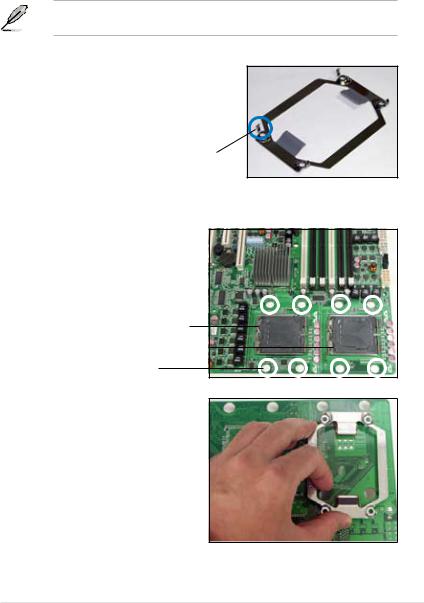
2.2.3Support kits for the motherboard
For additional protection from motherboard breakage due to the weight of the CPU heatsinks, your motherboard package comes with CEK springs that you can use as weight support. Install the CEK springs before installing the motherboard.
If your chassis is SSI EEB 3.61 compliant, we recommend that you use the CEK springs; otherwise, use the support plates kit.
Each CEK spring has four hooks to match the designated holes around the CPU area.
Hook
To install the CEK spring:
1.Locate the CPU heatsink holes on the motherboard.
Socket for CPU2
Socket for CPU1
Heatsink hole
2.Position the CEK spring underneath the motherboard, then match the CEK spring hooks to the CPU1 heatsink holes.
ASUS DSBV-D |
2- |
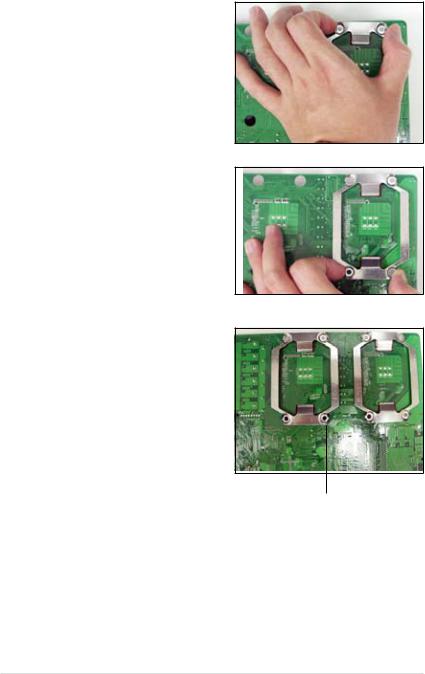
3.Press the upper spring hooks inward, then insert to the upper CPU heatsink holes until they snap in place.
4.Press the lower spring clips inward, then insert to the lower CPU heatsink holes until they snap in place.
5.If you installed a second CPU, repeat steps 2 to 4 to install the CEK spring to the CPU2 heatsink holes.
The CEK springs appear as shown when installed.
CEK spring screw hole
2- |
Chapter 2: Hardware information |
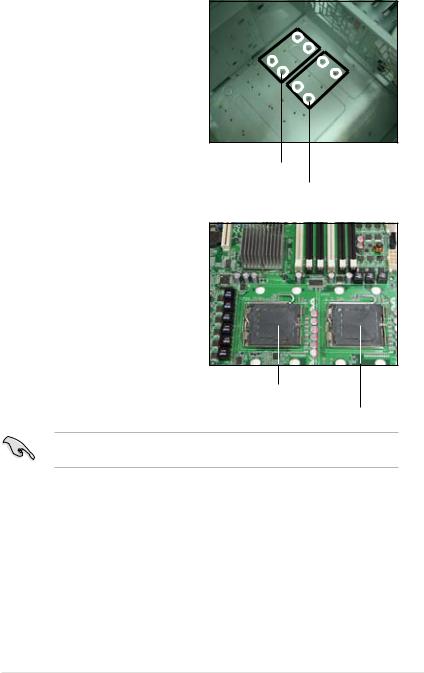
6.Before installing the motherboard into the chassis, locate the standoffs
that should match the eight (8) CEK spring screw holes.
Standoffs for CPU1
Standoffs for CPU2
7.Install the motherboard with the external I/O ports toward the chassis rear panel. The CPU sockets should be right on top of their respective standoffs.
Socket for CPU2
Socket for CPU1
Make sure that the standoffs perfectly match the CEK spring screw holes; otherwise, you can not install the CPU heatsinks properly.
8.Secure the motherboard with six (6) screws. Refer to section “2.2.2 Screw holes” for illustration.
ASUS DSBV-D |
2- |
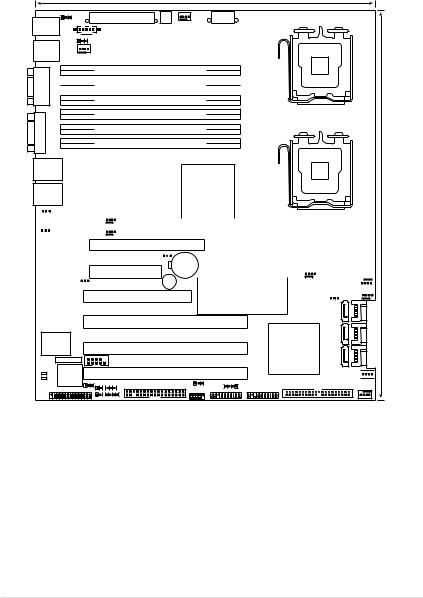
2.2.4Motherboard layouts
DSBV-D
|
|
|
|
|
|
26.7cm (10.5in) |
PS/2 |
KBPWR1 |
|
ATXPWR1 |
|
ATX12V1 |
|
|
PSUSMB1 |
ATX12V2 |
CPU_FAN1 |
|||
T: Mouse |
|
|
|
|||
B: Keyboard |
|
|
|
D |
|
|
|
|
USBPW12 |
|
|
||
USB1 |
|
DSBV- |
|
CPU1 |
||
|
|
|
|
|||
USB2 |
FBD_FAN1 |
|
|
|
||
|
|
|
|
|||
FB-DIMM_12 (64/72 bit, 240-pin module)
COM1 |
FB-DIMM_11 (64/72 bit, 240-pin module) |
|
|
FB-DIMM_10 (64/72 bit, 240-pin module) |
|
|
FB-DIMM_02 (64/72 bit, 240-pin module) |
|
VGA1 |
FB-DIMM_01 (64/72 bit, 240-pin module) |
|
FB-DIMM_00 (64/72 bit, 240-pin module) |
||
|
||
|
CPU2 |
RJ-45
(LAN1)
Intel®
RJ-45 5000V (LAN2)
|
|
|
LAN_BW1 |
|
REAR_FAN1 |
|
DIP_SW1 |
|
|
|
|
|
|
|
|
|||||||||||||||
|
|
|
|
Intel® |
|
|
|
|
|
|
|
|
|
|
|
|
|
|
|
|
|
|
|
|
|
|
|
|||
|
|
|
|
|
|
|
|
|
|
|
|
|
|
|
|
|
|
|
|
|
|
|
|
|
|
|
||||
|
|
|
|
|
|
|
|
|
|
|
|
|
|
|
|
|
|
|
|
|
|
|
|
|
|
|
||||
|
|
|
EN1 |
82563EB |
|
|
REAR_FAN2 |
|
|
|
|
|
|
|
|
|
|
|
|
|
|
|
|
|
|
|
|
|||
LAN_ |
|
|
|
|
|
|
|
|
|
|
|
|
|
|
|
|
|
|
|
|
|
|
||||||||
|
|
|
|
|
|
|
|
|
|
|
|
|
|
|
|
|
|
|
||||||||||||
|
|
|
|
|
|
|
|
|
|
PCIE1 |
|
|
|
|
|
|
|
|
|
|
|
|
|
|
|
|
|
|
||
|
|
|
|
|
|
|
|
|
|
|
|
|
|
|
|
|
|
|
|
|
|
|
|
|
|
|
|
|||
|
|
|
|
|
|
|
|
|
|
|
CLRTC1 |
|
|
|
|
|
|
|
CR2032 3V |
|
|
|
|
|
|
|
|
|||
|
|
|
|
|
|
|
|
|
|
|
|
|
|
|
|
|
|
|
|
|
|
|
|
|
|
|
|
|||
|
|
|
|
|
|
|
|
|
PCIE2 |
|
|
|
|
|
|
|
Lithium Cell |
|
|
|
|
CPU_FAN2 |
|
|||||||
|
|
|
ATI |
|
|
|
|
|
|
|
|
|
|
|
CMOS Power |
|
|
|
|
|
||||||||||
|
|
|
ES1000 |
|
|
|
|
|
|
|
|
|
|
|
|
|
|
|
|
|
|
|
|
|
|
|
|
FRNT_FAN4 |
|
|
|
|
|
|
|
|
VGA_EN1 |
|
PCI3 |
|
|
|
|
|
|
|
BUZZER1 |
|
|
|
|
|
|
|
|
||||||
|
|
|
|
|
|
|
|
|
|
|
RAID_SEL1 |
|
||||||||||||||||||
|
|
|
|
|
|
|
|
|
|
|
|
|
|
|
|
|
|
|
|
|
|
|
|
|
|
|
|
|
FRNT_FAN3 |
|
|
|
|
|
|
|
|
|
|
|
|
|
|
|
|
|
|
|
|
|
|
|
|
|
|
|
|
|
|
|
|
|
|
|
|
|
ASMB3 |
|
|
|
|
|
PCIX4 |
|
|
Super |
|
|
PCIX5 |
Intel |
® |
|
I/O |
|
|
|
|
||
|
|
|
6321ESB |
|||
|
|
COM2 |
|
PCIX6 |
||
+12V4LED1 |
8Mb |
|
|
|
|
|
SB_PWR1 |
FWH |
SGIOP1 |
FLOPPY1 |
USBPW34 |
|
|
|
|
HDLED1AUX_PANEL1 PRI_IDE1 |
|
|||
LPT1 |
RECOVERY1 |
|
USB34 PANEL1 |
|
||
|
|
BPSMB1 |
|
|
|
|
SATA5 SATA3 SATA1
SATA6 SATA4 SATA2
FRNT_FAN2 





FRNT_FAN1
30.5cm (12in)
2- |
Chapter 2: Hardware information |
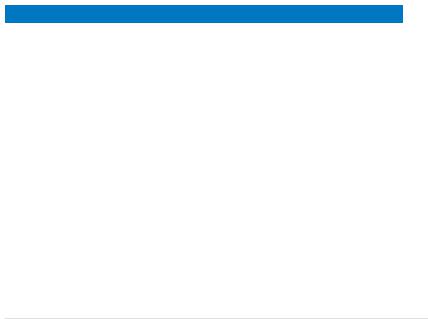
2.2.5Layout contents
Slots/Sockets |
Page |
|
1. |
CPU sockets |
2-9 |
2. |
FB-DIMM sockets |
2-14 |
3. |
PCI-X slots |
2-22 |
4. |
DDR2 SODIMM socket |
2-22 |
5. PCI Express x8 slot |
2-23 |
|
6. PCI Express x16 slot |
2-23 |
|
|
|
|
Jumpers |
Page |
|
1. |
Clear RTC RAM (CLRTC1) |
2-24 |
2. |
LAN bandwidth setting (3-pin LAN_BW1) |
2-25 |
3. |
USB device wake-up (3-pin USBPW12, USBPW34) |
2-25 |
4. |
Keyboard power (3-pin KBPWR1) |
2-26 |
5. |
VGA controller setting (3-pin VGA_EN1) |
2-26 |
6. |
LAN controller setting (3-pin LAN1_EN1) |
2-27 |
7. |
Intel® 6321ESB SATA port S/W RAID setting (3-pin RAID_SEL1) |
2-27 |
8. |
Force BIOS recovery setting (3-pin RECOVERY1) |
2-28 |
|
|
|
Switch |
|
Page |
1. |
DIP switches (DIP_SW1) |
2-33 |
|
|
|
Rear panel connectors |
Page |
|
1. |
PS/2 mouse port (green) |
2-29 |
2. |
PS/2 keyboard port (purple) |
2-29 |
3. |
USB 2.0 ports 1 and 2 |
2-29 |
4. |
Serial (COM1) port |
2-29 |
5. |
Video Graphics Adapter port |
2-29 |
6. |
LAN (RJ-45) ports |
2-29 |
ASUS DSBV-D |
2- |

Internal connectors |
Page |
|
1. |
Floppy disk drive connector (34-1 pin FLOPPY1) |
2-30 |
2. |
IDE connector (40-1 pin PRI_IDE) |
2-30 |
3. |
Serial ATA connectors (7-pin SATA1, SATA2, SATA3, |
2-31 |
|
SATA4, SATA5, SATA6 ) |
|
4. |
Hard disk activity LED connector (4-pin HDLED1) |
2-31 |
5. |
USB connector (10-1 pin USB34) |
2-32 |
6. |
Serial port connector (10-1 pin COM2) |
2-32 |
7. |
CPU and system fan connectors (4-pin CPU_FAN1/2, |
2-33 |
|
REAR_FAN1/2, FRNT_FAN1/2/3/4, FBD_FAN1) |
|
8. |
Power supply SMBus connector (5-pin PSUSMB1) |
2-33 |
9. |
SSI power connectors (24-pin ATXPWR1, 8-pin ATX12V1, |
2-34 |
|
4-pin ATX12V2) |
|
10. |
Parallel port connector (26-1 pin LPT1) |
2-35 |
11. |
Backplane SMBus connector (6-1 pin BPSMB1) |
2-35 |
12. |
Serial General Purpose Input/Output connector |
2-36 |
13. |
System panel connector (20-1 pin PANEL1) |
2-40 |
14. System panel auxiliary connector (20-2 pin AUX_PANEL1) |
2-38 |
|
2- |
Chapter 2: Hardware information |
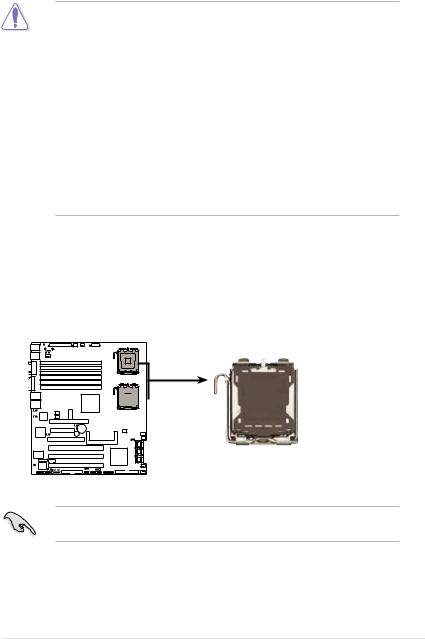
2.3Central Processing Unit (CPU)
The motherboard comes with a surface mount LGA771 socket designed for the
Intel® Xeon® Dual Core processor.
•Your boxed Intel® Xeon® LGA771 processor package should
come with installation instructions for the CPU and heatsink. If the instructions in this section do not match the CPU documentation, follow the latter.
•Upon purchase of the motherboard, make sure that the PnP cap is on the socket and the socket contacts are not bent. Contact your retailer
immediately if the PnP cap is missing, or if you see any damage to the PnP cap/socket contacts/motherboard components. ASUS will shoulder the cost of repair only if the damage is shipment/transit-related.
•Keep the cap after installing the motherboard. ASUS will process Return
Merchandise Authorization (RMA) requests only if the motherboard comes with the cap on the LGA771 socket.
•The product warranty does not cover damage to the socket contacts resulting from incorrect CPU installation/removal, or misplacement/loss/ incorrect removal of the PnP cap.
2.3.1Installing the CPU
To install a CPU:
1.Locate the CPU socket on the motherboard.
DSBV-D
CPU1
CPU2 

DSBV-D CPU LGA771
Before installing the CPU, make sure that the socket box is facing towards you and the load lever is on your left.
ASUS DSBV-D |
2- |
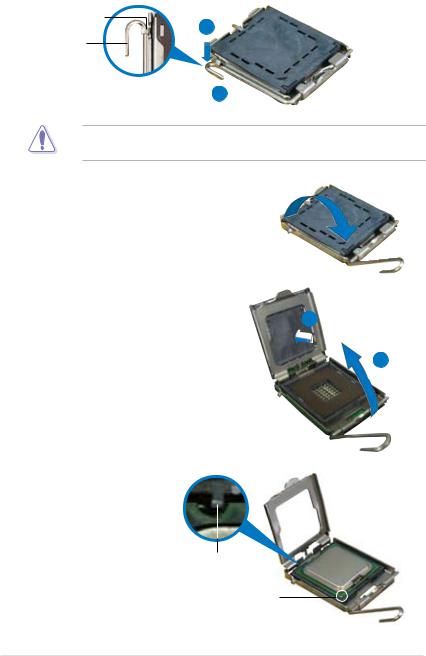
2.Press the load lever with your thumb (A), then move it to the left (B) until it is released from the retention tab.
Retention tab
A
Load lever
B |
|
|
PnP cap |
|
|
||
|
|
|
|
|
|
||
This side of the socket box |
|||
|
should face you. |
||
To prevent damage to the socket pins, do not remove the PnP cap unless you are installing a CPU.
3.Lift the load lever in the direction of the arrow to a 135º angle.
4.Lift the load plate with your
thumb and forefinger to a 100º |
|
|
B |
angle (A), then push the PnP |
|
|
|
cap from the load plate window |
|
|
|
to remove (B). |
|
|
A |
|
|
|
|
|
|
|
|
|
Load plate |
||
5.Position the CPU over the socket, making sure that the gold triangle
is on the bottom-left corner of the socket. The socket alignment key should fit into the
CPU notch.
Alignment key
Gold triangle mark
2-10 |
Chapter 2: Hardware information |
